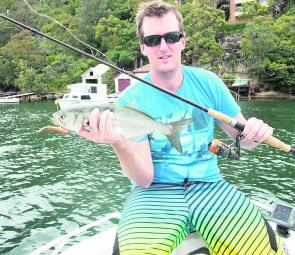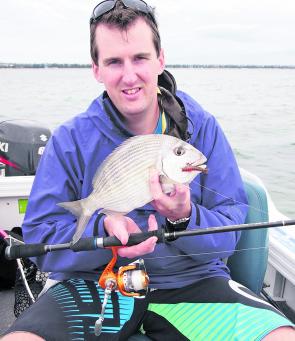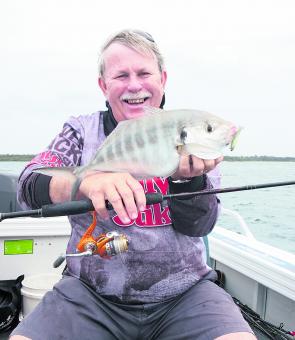February will see schools of tailor and Australian salmon getting stuck into baitfish in Botany Bay and Port Hacking. You will also find that a few will move up into the Cooks and Georges rivers with the cleaner water as the tide rises.
There are two types of Australian salmon, the Eastern Australian (Arripis trutta) and the Western Australian (Arripis truttaceus) and it’s the eastern that you will find over here. The colour on the backs of these fish can vary from greyish green to a steely blue, usually with yellow to blackish spots. They can also be an olive green to a steel blue with small dark spots on the back and upper sides, with a pale yellow-green to silver white below. The pectoral fins are usually bright yellow, but this can vary from area to area.
Tailor, on the other hand, are of a greenish blue or blue colour on their backs, and the sides and belly are silvery. Their fins are pale green, tinged with yellow, and the base of the pectoral fins is bluish. Both jaws have numerous strong, sharp teeth, and the lower jaw protrudes. The caudal fin is forked, with broad lobes. If you are going to keep either of these species for a feed, you will need to bleed them as soon as possible. To do this, cut the throat of the fish and let it bleed out. Simply cut the underside of the fish, starting at the lower front fins and finishing the deep incision at the lower side of the mouth.
Although a commercially important fish, tailor are somewhat oily and strong flavoured. To minimise this and any ‘fishy’ taste, they should be gutted, iced promptly, and eaten fresh. If the fish is not quickly taken care of in this way, the meat will rapidly deteriorate, becoming soft and mushy, and assuming a steadily greyer pigmentation.
I have found over the years that the best time to target Australian salmon and tailor is usually at dawn, dusk, and on overcast days, but I have also caught them during the middle of the day when the sun has been very high in the sky.
When chasing Australian salmon and tailor off the beach, rocks and breakwalls, I prefer to use a 3.6m rod, mounted with a 6000-8000 size spin reel or a 5.5-6” sidecast. These would be spooled with 10-15kg line. Having a rod of this length will give you the advantage when you have to use the waves on the beach or the wash on the rocks to help land the fish. A rod of this length will also assist when lifting a fish off the lower ledge when rock fishing.
If I was using either whole pilchards or garfish on a set of ganged hooks, I would have the ball sinking running directly down onto the swivel, and the leader would be about 50-60cm in length.
Both Australian salmon and tailor will put on a feisty display of acrobatics while trying to dislodge the hooks from their mouths, and many an angler has cursed when these have pulled free. I have found that if you watch your line you can usually tell when they are about to head to the surface and start jumping.
Before they leave the water, I will slowly and slightly drop my rod tip towards the water, while at the same time not allowing any loose line. Nine times out of 10 this will decrease the strain being put on the line and also decrease the fish’s leverage advantage for dislodging the hooks. Once the fish is back in the water, you can then start to slowly raise the rod tip and apply pressure on the fish by recovering line.
This technique can be used whether you are fishing out of a boat, off a beach, from the rocks, or off the shore.
Very slow trolling pilchards and garfish rigged on either a set of gangs, double snooded or single hooks are a very effective way of targeting salmon and tailor when they are being finicky. You can also try trolling bluebait and whitebait the same way, but downsize the hooks.
I have found some solder wrapped around the shaft of the first hook will act as a keel and stop the bait from spinning.
Starting from the northern side of Botany Bay, you could try Henry Head, Bare Island, Yarra Bay, Trevally Alley, the end of the third runway, Brighton Beach to Dolls Point, the flats at Towra, The Oil Wharf, and Sutherland Point on the southern side of the bay.
In the Georges River try drifting between the Captain Cooks and Tom Uglys bridges.
In Port Hacking you will find that the back of most of the bays and the main channel will have tailor and salmon working bait schools. One of my favourite spots is the dropoff on a run-in tide at Lilli Pilli.
Tailor and salmon are not be the only species of fish available in February. There will be plenty of flathead, bream, and silver trevally will be on the chew. Just remember when anchored up to berley for better results. Pilchards mixed in with chicken pellets and bread is always a good combination.
Reads: 4660
Keep an eye out for those working birds, as there may be tailor beneath the bait schools.

Andrew Humphries had never caught a tarwhine before. He managed to get this one working a Gulp Shrimp over the flats at Towra Point.

The author fished 2” Gulps over the flats off Silver Beach at Kurnell to score this silver trevally.




